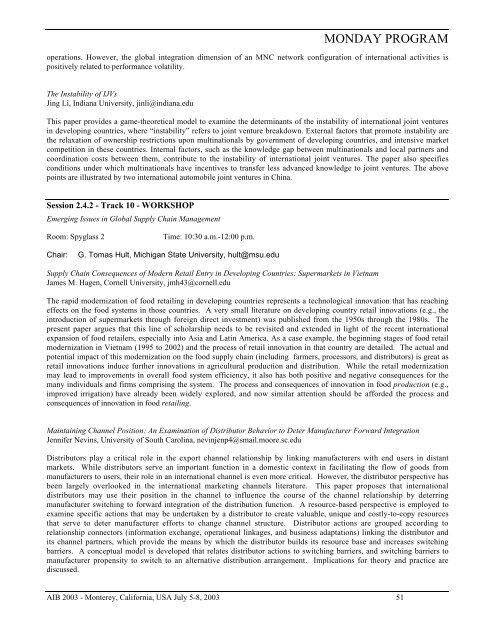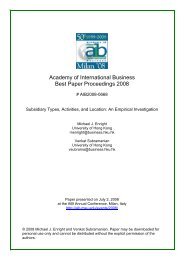MONDAY PROGRAMoperations. However, the global integration dimension <strong>of</strong> an MNC network configuration <strong>of</strong> international activities ispositively related to performance volatility.The Instability <strong>of</strong> IJVsJing Li, Indiana University, jinli@indiana.eduThis paper provides a game-theoretical model to examine the determinants <strong>of</strong> the instability <strong>of</strong> international joint venturesin developing countries, where “instability” refers to joint venture breakdown. External factors that promote instability arethe relaxation <strong>of</strong> ownership restrictions upon multinationals by government <strong>of</strong> developing countries, and intensive marketcompetition in these countries. Internal factors, such as the knowledge gap between multinationals and local partners andcoordination costs between them, contribute to the instability <strong>of</strong> international joint ventures. The paper also specifiesconditions under which multinationals have incentives to transfer less advanced knowledge to joint ventures. The abovepoints are illustrated by two international automobile joint ventures in China.Session 2.4.2 - Track 10 - WORKSHOPEmerging Issues in Global Supply Chain ManagementRoom: Spyglass 2Time: 10:30 a.m.-12:00 p.m.Chair: G. Tomas Hult, <strong>Michigan</strong> <strong>State</strong> University, hult@msu.eduSupply Chain Consequences <strong>of</strong> Modern Retail Entry in Developing Countries: Supermarkets in VietnamJames M. Hagen, Cornell University, jmh43@cornell.eduThe rapid modernization <strong>of</strong> food retailing in developing countries represents a technological innovation that has reachingeffects on the food systems in those countries. A very small literature on developing country retail innovations (e.g., theintroduction <strong>of</strong> supermarkets through foreign direct investment) was published from the 1950s through the 1980s. Thepresent paper argues that this line <strong>of</strong> scholarship needs to be revisited and extended in light <strong>of</strong> the recent internationalexpansion <strong>of</strong> food retailers, especially into Asia and Latin America. As a case example, the beginning stages <strong>of</strong> food retailmodernization in Vietnam (1995 to 2002) and the process <strong>of</strong> retail innovation in that country are detailed. The actual andpotential impact <strong>of</strong> this modernization on the food supply chain (including farmers, processors, and distributors) is great asretail innovations induce further innovations in agricultural production and distribution. While the retail modernizationmay lead to improvements in overall food system efficiency, it also has both positive and negative consequences for themany individuals and firms comprising the system. The process and consequences <strong>of</strong> innovation in food production (e.g.,improved irrigation) have already been widely explored, and now similar attention should be afforded the process andconsequences <strong>of</strong> innovation in food retailing.Maintaining Channel Position: An Examination <strong>of</strong> Distributor Behavior to Deter Manufacturer Forward IntegrationJennifer Nevins, University <strong>of</strong> South Carolina, nevinjenp4@smail.moore.sc.eduDistributors play a critical role in the export channel relationship by linking manufacturers with end users in distantmarkets. While distributors serve an important function in a domestic context in facilitating the flow <strong>of</strong> goods frommanufacturers to users, their role in an international channel is even more critical. However, the distributor perspective hasbeen largely overlooked in the international marketing channels literature. This paper proposes that internationaldistributors may use their position in the channel to influence the course <strong>of</strong> the channel relationship by deterringmanufacturer switching to forward integration <strong>of</strong> the distribution function. A resource-based perspective is employed toexamine specific actions that may be undertaken by a distributor to create valuable, unique and costly-to-copy resourcesthat serve to deter manufacturer efforts to change channel structure. Distributor actions are grouped according torelationship connectors (information exchange, operational linkages, and business adaptations) linking the distributor andits channel partners, which provide the means by which the distributor builds its resource base and increases switchingbarriers. A conceptual model is developed that relates distributor actions to switching barriers, and switching barriers tomanufacturer propensity to switch to an alternative distribution arrangement. Implications for theory and practice arediscussed.AIB 2003 - Monterey, California, USA July 5-8, 2003 51
MONDAY PROGRAMAn Integration-Based Taxonomy <strong>of</strong> Supply Chain ConfigurationsNevana Yakova, Rutgers University, nvyakova@pegasus.rutgers.eduM.A. Lejeuen, Rutgers University, Mlejeune@andromeda.rutgers.eduSupply management is <strong>of</strong>ten presented as the ultimate source for creating sustainable competitive breakthroughs and ischaracterized by the abandonment <strong>of</strong> single companies' barriers separating the different entities involved in the supplychain. Supply chain management is at the confluence <strong>of</strong> many other disciplines and, consequently, the body <strong>of</strong> literaturedevoted to it is very heterogeneous. The main contribution <strong>of</strong> this paper is to provide a framework related to the four maintypes <strong>of</strong> supply chain configurations, that we refer to as the four C’s in supply chain management: the communicative,coordinated, collaborative and co-opetitive supply chain configurations. The four discriminative variables in the taxonomyare trust, decision-making process, goal congruence and information flow. We complement the taxonomy by introducingtwo transitional supply chain configurations.Antecedents and Consequences <strong>of</strong> Opportunism in the Taiwanese Marketing ChannelCheng-Nan Chen, National Penghu Institute <strong>of</strong> Technology and National Cheng Kung University,cnchen@mail.ncku.edu.twShueh-Chin Ting, Far East Institute <strong>of</strong> Technology, tingsc@ms49.hinet.netShu-Yuan Huang, National Cheng Kung University, tingsc@ms49.hinet.netThe existence <strong>of</strong> opportunism in partnership makes the cooperative relationship to be unstable. Past researches about thistopic always discussed the relation between a single variable and opportunism. This study is to make a comprehensivediscussion about the opportunism’s antecedents (uncertainty, information asymmetry, asset specificity and relationalexchange) and consequences (transaction cost, trust, commitment, performance and cooperation). Data were from computerretailers located in three major cities in Taiwan (Taipei, Taichung, and Kaohsiung) and were collected by personalinterviews. These retailers were asked to evaluate the relationships with their biggest suppliers. The results indicate that (1)uncertainty and information asymmetry have a significant positive influence on opportunistic behaviors, (2) assetspecificity and relational exchange have a significant negative influence on opportunistic behaviors, (3) opportunisticbehaviors have a significant positive influence on transaction cost, and (4) opportunistic behaviors have a significantnegative influence on trust, commitment, performance and cooperation in their partnerships. Some implications formanagement are discussed and some suggestions for further research are also forwarded.AIB 2003 - Monterey, California, USA July 5-8, 2003 52
- Page 1 and 2: AIB2 0 0 3The Power of Ideas and In
- Page 3 and 4: The 45th Annual Meetingof the Acade
- Page 5 and 6: AIB 2003 - Monterey, California, US
- Page 7 and 8: SATURDAYSATURDAY - 8:30 a.m.- 4:00
- Page 9 and 10: MONDAY - 10:00-10:30 a.m.Coffee Bre
- Page 11 and 12: 3.8 - TUESDAY - 1:30-3:00 p.m.Sessi
- Page 13 and 14: AIB 2003 - Monterey, California, US
- Page 15 and 16: SUNDAY - July 6, 2003SUNDAY PROGRAM
- Page 17 and 18: SUNDAY PROGRAMUsing Political and E
- Page 19 and 20: Host country product diversity and
- Page 21 and 22: Time will Tell? Socialisation towar
- Page 23 and 24: SUNDAY PROGRAMNational Competitiven
- Page 25 and 26: Strategies for Closed Markets: Camp
- Page 27 and 28: SUNDAY PROGRAMChinese Foreign Direc
- Page 29 and 30: SUNDAY PROGRAMThe Impact of Copyrig
- Page 31 and 32: SUNDAY PROGRAMSession 1.2.1 BALASMa
- Page 33 and 34: SUNDAY PROGRAMThe Effect of Nationa
- Page 35 and 36: SUNDAY PROGRAMSession 1.2.4 - Track
- Page 37 and 38: The Determinants of Competitive Adv
- Page 39 and 40: Session 1.2.7 - Track 1 - PANELSUND
- Page 41 and 42: MONDAY - July 7, 2003MONDAY PROGRAM
- Page 43 and 44: MONDAY PROGRAMSession 2.3.3 - Track
- Page 45 and 46: MONDAY PROGRAMInter-firm linkages a
- Page 47 and 48: Session 2.3.6 - Track 6 - COMPETITI
- Page 49 and 50: The Decision to Privatize as the Di
- Page 51: MONDAY PROGRAMPrivatization in Indi
- Page 55 and 56: MONDAY PROGRAMSession 2.4.4 - Track
- Page 57 and 58: Session 2.4.6 - Track 6 - WORKSHOPB
- Page 59 and 60: MONDAY PROGRAMSession 2.4.8 - Track
- Page 61 and 62: MONDAY PROGRAMCultural distance and
- Page 63 and 64: Too much similarity causes differen
- Page 65 and 66: MONDAY PROGRAMThe Impact of Firm Pe
- Page 67 and 68: MONDAY PROGRAMBusiness Associations
- Page 69 and 70: MONDAY PROGRAMInternational Marketi
- Page 71 and 72: MONDAY PROGRAMThe Taxation of Indus
- Page 73 and 74: MONDAY PROGRAMSession 2.5.3 - Track
- Page 75 and 76: Explaining Subsidiary Network Embed
- Page 77 and 78: Top Managers’ Influence on Innova
- Page 79 and 80: MONDAY PROGRAMSession 2.5.8 - Track
- Page 81 and 82: TUESDAY PROGRAMvariable that seems
- Page 83 and 84: TUESDAY PROGRAMHow Corruption Affec
- Page 85 and 86: TUESDAY PROGRAMH-shares as well as
- Page 87 and 88: TUESDAY PROGRAMCooperative Strategi
- Page 89 and 90: Political Connectedness and the For
- Page 91 and 92: TUESDAY PROGRAMSession 3.7.3 - Trac
- Page 93 and 94: TUESDAY PROGRAMmovers to neutralise
- Page 95 and 96: TUESDAY PROGRAMSession 3.7.6 - Trac
- Page 97 and 98: TUESDAY PROGRAMthey plan strategica
- Page 99 and 100: TUESDAY PROGRAMSession 3.8.1 - Trac
- Page 101 and 102: TUESDAY PROGRAMmodel among the four
- Page 103 and 104:
TUESDAY PROGRAMextent to which MNEs
- Page 105 and 106:
TUESDAY PROGRAMSession 3.8.6 - Trac
- Page 107 and 108:
TUESDAY PROGRAMSession 3.8.8 - Trac
- Page 109 and 110:
Strategic Modularization, Evolution
- Page 111 and 112:
TUESDAY PROGRAMHow Corporate Govern
- Page 113 and 114:
Imitating and Learning from Others:
- Page 115 and 116:
TUESDAY PROGRAMSession 3.9.8 - Trac
- Page 117 and 118:
TUESDAY PROGRAMWal-Mart Vs. Carrefo
- Page 119 and 120:
TUESDAY PROGRAMthe b-entity, is dev
- Page 121 and 122:
TUESDAY PROGRAMThe Expatriate Exper
- Page 123 and 124:
Track 9 - Finance, Accounting, and
- Page 125 and 126:
List of ParticipantsAdler, Nancy J.
- Page 127 and 128:
Pangarkar, Nitin 1.1.1, 2.3.1, 3.8.
















